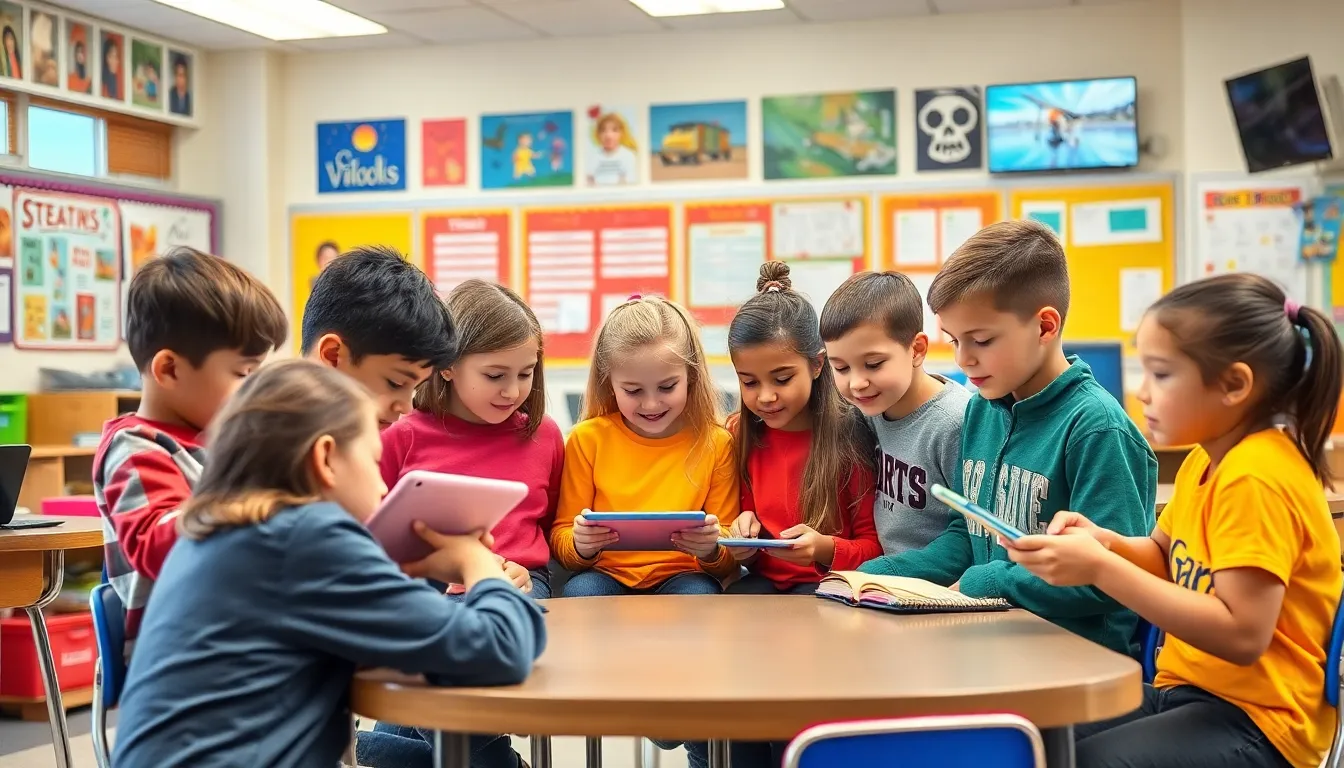In a world where kids can learn to code before they can tie their shoes, edtech for K-12 is revolutionizing the classroom experience. Gone are the days of dusty textbooks and chalkboards that squeak louder than a cat on a hot tin roof. Today’s students are navigating interactive platforms that make learning feel more like a video game than a chore.
Imagine a classroom where personalized learning meets engaging content, all while teachers sip their coffee in peace. With the right tools, students can explore subjects at their own pace, collaborate on projects from anywhere, and even get instant feedback without the pressure of a pop quiz. Edtech isn’t just a trend; it’s the future of education, and it’s here to make learning fun, accessible, and downright exciting for every student.
Table of Contents
ToggleOverview of Edtech for K-12
Edtech plays a crucial role in transforming K-12 education. Interactive platforms enhance student engagement and replace traditional learning methods. Personalized learning options enable students to advance at their own pace, catering to individual needs. Collaboration across distances creates opportunities for teamwork among students, even in separate locations. Immediate feedback allows educators to address concerns, ensuring concepts are grasped effectively.
Various tools and applications support this educational shift. Learning management systems centralize resources and assignments, streamlining both teaching and administration. Digital assessment tools provide real-time insights into student performance, helping educators refine their strategies. Gamification elements incorporate play into learning, motivating students and fostering retention.
Investments in edtech also yield significant benefits. Research shows that schools adopting advanced technology experience improved academic outcomes. According to a study by the Bill & Melinda Gates Foundation, personalized learning initiatives can boost student achievement by as much as 30 percent. Such evidence underscores the importance of integrating technology into the curriculum.
Professional development for teachers remains essential in this context. Training programs equip educators with the skills needed to effectively implement and integrate technology in the classroom. Ongoing support helps educators remain proficient in utilizing new tools, positioning them to inspire their students.
Overall, the adoption of edtech in K-12 schools reshapes educational landscapes. Whether through enhanced engagement, personalized learning, or improved outcomes, technology emerges as a critical component of modern education. The commitment to leveraging these tools ensures a brighter and more accessible future for all students.
Benefits of Edtech in K-12 Education

Edtech offers numerous advantages that enhance the learning environment for K-12 students. These tools create opportunities for personalized learning, allowing every student to thrive based on individual needs.
Enhanced Learning Experiences
Innovative curricula arise through the integration of edtech, fostering interactive and immersive lessons. Students engage with multimedia resources, strengthening understanding and retention. Digital platforms also enable access to a wealth of information beyond traditional textbooks. Teachers utilize learning management systems to tailor instruction and provide immediate feedback, adjusting methods based on student performance. Gamified elements motivate learners further, making education enjoyable while promoting knowledge acquisition. Remarkably, research indicates that personalized learning initiatives can boost student achievement by up to 30 percent, illustrating the impact of technology on educational outcomes.
Improved Student Engagement
Incorporating technology in classrooms keeps students actively involved in their education. Research shows that interactive tools enhance motivation, as students participate in collaborative projects and discussions. Virtual classrooms allow for flexible learning, catering to diverse schedules and learning preferences. Real-time assessments help track progress, ensuring that educators address gaps in understanding promptly. Developing critical thinking skills becomes easier with simulations and problem-solving tasks integrated into lessons. Ultimately, edtech transforms the learning experience, making it more relevant and engaging for today’s students.
Popular Edtech Tools for K-12
K-12 education benefits tremendously from various edtech tools. These tools enhance learning experiences and streamline classroom management.
Learning Management Systems
Learning Management Systems (LMS) facilitate course management and improve communication between students and educators. They enable teachers to organize lesson plans and track student progress efficiently. Many LMS platforms, like Google Classroom and Canvas, provide collaborative spaces for submitting assignments and practicing discussions. Engaging features such as forums and quizzes keep students connected and active in their learning journey. Data shows that incorporation of LMS can improve student retention rates by up to 20 percent, reflecting their effectiveness in promoting organizational skills and accountability among students.
Interactive Learning Platforms
Interactive Learning Platforms provide immersive experiences that cater to diverse learning styles. Tools like Kahoot and Nearpod offer game-based learning opportunities that captivate students’ attention. Innovative platforms enable educators to create engaging lessons enriched with videos, quizzes, and simulations. Active participation fosters a sense of community and encourages deeper understanding of the material. Research indicates that interactive elements can enhance information retention by up to 25 percent. Therefore, these platforms play a vital role in transforming traditional lesson plans into dynamic educational experiences.
Challenges in Implementing Edtech for K-12
Implementing edtech in K-12 settings presents several challenges that schools must navigate effectively.
Equity and Access Issues
Access to technology varies significantly among students. Some face obstacles like insufficient devices or unreliable internet connections, impacting their learning opportunities. Research shows that about 15% of students lack consistent access to technology, which exacerbates educational disparities. Schools must develop strategies to ensure equitable access for all, such as providing devices and offering internet solutions. Equity in technology access is crucial for fostering an inclusive learning environment where every student can thrive.
Teacher Training and Support
Effective use of edtech relies heavily on adequate teacher training. Many educators report feeling unprepared to integrate technology into their classrooms, with 25% stating they lack the necessary skills. Comprehensive professional development programs are essential to address this gap. Continuous support, mentorship, and resources can empower teachers to utilize edtech tools effectively. Schools that prioritize teacher training create a more confident and capable teaching workforce, enhancing student learning experiences.
Future Trends in Edtech for K-12
Artificial intelligence (AI) continues to gain traction in K-12 education, promising to personalize learning experiences further. By analyzing individual student data, AI-driven tools recommend tailored resources and adaptive learning paths. This technology enhances engagement by delivering content that aligns with student interests and skill levels.
Augmented reality (AR) and virtual reality (VR) are reshaping educational experiences, offering immersive environments for students. These technologies allow learners to explore complex concepts in engaging ways, such as virtual field trips or interactive science labs. Research shows that using AR and VR can augment retention rates significantly.
Gamification remains a prominent trend, effectively increasing student motivation. Tools that incorporate game elements—like achievements and leaderboards—encourage healthy competition and persistent engagement. This strategy aligns well with findings that suggest gamified learning can improve achievement by enhancing the educational experience.
Collaborative platforms are growing, empowering students to work together asynchronously. These tools support project-based learning, enabling learners to connect with peers beyond their classrooms. Online collaboration fosters communication skills and teamwork, crucial for future workforce readiness.
Data analytics plays a crucial role in education, helping educators identify trends and address learning gaps. Analyzing performance data enables teachers to modify instruction dynamically, ensuring targeted support for students. Continuous feedback loops created through these systems support ongoing improvement.
Lastly, the push for equity in education favors the development of accessible technologies. Schools aim to bridge gaps in access, ensuring that every student benefits from digital learning tools. By providing devices and internet access, educational institutions can foster inclusive environments that prioritize learning for all.
These trends indicate an ongoing evolution of K-12 education, where technology continually transforms teaching and learning dynamics.
The integration of edtech in K-12 education is reshaping how students learn and interact with information. By fostering personalized learning experiences and enhancing engagement through interactive tools, technology is paving the way for a more inclusive and dynamic educational landscape.
Despite the challenges of access and teacher preparedness, the potential benefits of edtech cannot be overlooked. As schools continue to adopt innovative technologies, the focus on equity and effective training will be crucial for maximizing the impact on student achievement.
Looking ahead, advancements in AI, AR, and data analytics promise to further revolutionize teaching and learning, ensuring that all students have the opportunity to thrive in a digital age. The future of K-12 education is bright, driven by the transformative power of technology.

